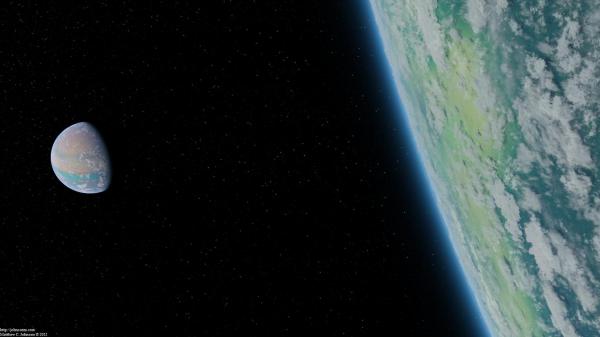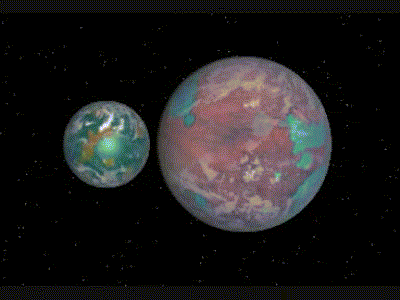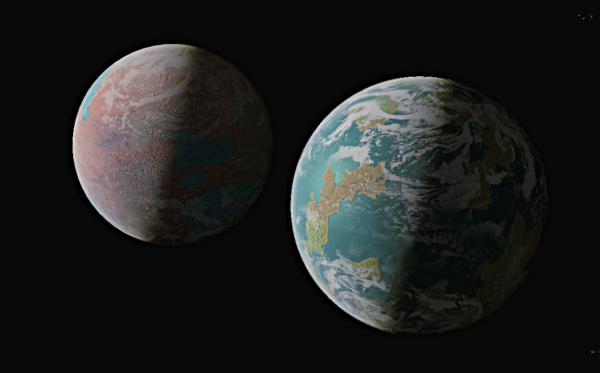BY LETTER
Fiarro Twin Worlds, The
Galactography > Regions of Space > Middle Regions/Hinter-regions
Galactography > Sephirotic Empires > Non-Coercive Zone (NoCoZo)
Galactography > Systems and Worlds > Systems & Worlds E - F
Galactography > Sephirotic Empires > Non-Coercive Zone (NoCoZo)
Galactography > Systems and Worlds > Systems & Worlds E - F
Twin Terrestrial worlds in Vela | |
 Image from Matthew C. Johnson | |
| Fiarro Major is the more Earth-like of the Twin planets, while Fiarro minor is a smaller, dryer world | |
Heteromorph worlds which have a strong tradition of psychological plasticity | |
| Star | HIP 43371 |
|---|---|
| Type | Dioscuran Gaian (twin terrestrial worlds) |
| Luminosity | 0.702 x Sol |
| Distance from Sol | 235 ly |
| Location | Argelander Plexus, constellation Vela |
| Planets | Fiarro Major and Fiarro Minor (tidally locked to each other) |

An eclipse of Fiarro Major by Fiarro Minor
Fiarro Major | |
| Mass | 1.1x Earth |
|---|---|
| radius | 1.02 x Earth |
Fiarro Minor | |
| Mass | 0.8 x Earth |
|---|---|
| radius | 0.85 x Earth |
 Image from Matthew C. Johnson | |
| A lush landscape on Fiarro Major; the smaller world Fiarro Minor hangs motionless in the sky of this tidally-locked world. | |
Major/Minor System Orbital Data
Average Separation: 210,450 km; the barycentre is located at an average distance of 88610 km from Fiarro Major
Period: 8.06 standard days
Mutual Orbit around HIP 43371
Period: 0.8 standard years
Semimajor Axis: 0.83 AU
Allegiance: Non-Coercive Zone (NoCoZo)
Colonised: 2271 AT
These two Earth-like planets formed over three billion years ago as a binary pair; binary planets are rare, but not vanishingly so. About fifty million years after solid objects began to accrete in the protoplanetary disc of this system, a Jovian-type world began to migrate toward the central star from its birthplace beyond the system's "frost-line" (at 1.15 AU from the star). As it moved inward, it crossed the orbit of a 2 Earth-mass Super-terrestrial protoplanet at about 0.8 AU (which remained relatively undisturbed by the Jovian's passage); continuing inward, it came very close to a 0.4 Earth-mass Terrestrial protoplanet at a distance of about 0.4 AU from the central star before finally settling into a 0.1 AU orbit around its parent star. The smaller protoplanet (which would later become Fiarro Major) was flung outward by the encounter onto a trajectory that would cause it to impact the Super-terrestrial (which would later become Fiarro Minor).
In the moments before impact, Fiarro Major was traveling at about 30 km/sec toward the larger world. striking Fiarro Minor at an angle of about 40 degrees from local vertical. The impact almost completely obliterated the smaller protoplanet and blew the crust and most of the mantle of the Super-terrestrial into space. The small part of Fiarro Major's core which escaped destruction rebounded off the now exposed core of Fiarro Minor and joined the rest of the debris in orbit around the remnants of the larger world. Most of the debris began to coalesce in orbit, beginning shortly after the impact; eventually, these bits and pieces would form what is now known as Fiarro Major. Of the debris that did not become a part of the new world, some rained down on the devastated landscape of Fiarro Minor (now greatly reduced in size and mass), some was ejected into the outer system (possibly to themselves impact the worlds in that direction), some fell inward toward the central star, and some might have conglomerated to form smaller bodies that orbited the Fiarro barycenter at distances beyond those of the two planets, but which have since been lost.
When the system was first colonised, by a secondary mission using re-conditioned colony ships from Argelander (itself newly colonised), the planets were both lifeless, although some evidence of ancient prebiotic chemistry has been found in strata on Fiarro Major. Considerable quantities of volatiles were brought into Fiarro Minor to improve the atmosphere and hydrosphere, but the problem of the eight-day-long rotation periods remained on both worlds. During the four-day-long night, severe frosts would occur on each world; during the long days the ground would often bake, and huge convection storms would build up in the atmosphere
 Image from Matthew C. Johnson | |
| An oasis on the dry world of Fiarro Minor | |
Before the terraformation process commenced, Fiarro Minor resembled Mercury in its composition (and Mars in appearance) much more than the more Earth-like Fiarro Major. Like Mercury, the planet has an essentially non-existent magnetosphere and is practically inert in terms of plate tectonics. Because of the high iron:silicate ratio on the smaller world (~86% iron to ~12% silicates), most (if not all) of the oxygen in the atmosphere had reacted long ago with the surface to form iron oxide (rust). For the same reason, any large bodies of open water appeared greenish rather than blue. Both planets had fairly thick atmospheres of more than 2 bars of pressure, but neither world had any significant free oxygen until introduced by the terraforming process.
To reduce the diurnal temperature differences the upper atmosphere was filled with a layer of aerostat 'weather machines', swarm technology that could reflect heat away from the surface in the hottest part of the day and back towards the surface at night
Face Morphing
The early colonists of the Fiarro Twin Worlds were mostly heteromorphs, human baselines who believed in 'morphological freedom' and employed biotechnology to change their own appearance at will and according to fashion. Sometimes a new face- or body- morph would become briefly popular and would be adopted by a significant fraction of the population; at other times individuals would merely invent their own 'new look', or swap appearances on a temporary or permanent basis.This rapid morphing of appearance was achieved using a system of adjustable biotech elements imbedded in the flesh and bones of the user; this allowed the heteromorph to change their facial features, body-shape and stature quite considerably over the space of a few hours. These systems included artificial, customised cell nuclei that coexist alongside the cell's natural nuclei but synthesise and release various factors to manipulate transcription and translation and therefore cell behaviour as required. Also included were genemods for rapidly modifying the extracellular matrix (the biological scaffolds that hold tissues in their morphology).
In due course a somewhat less-capable version of this technology was made available for use by the non-heteromorph inhabitants of this world, some of whom were willing to temporarily change their own appearance on occasion for fun or profit. This proprietary `face-morphing' technology was a major technological export from the Twin worlds during the Integration, by which time the system had become aligned with the Non-Coercive Zone.
 Image from Steve Bowers | |
| Foreshortened image of the Twin Worlds, showing relative sizes | |
Other Self
Some heteromorphs, accustomed to exchanging physical attributes with their friends and acquaintances, wished to take this process somewhat further; to really inhabit someone's skin, they reasoned, it would be necessary to acquire the mental attributes of that person as well. Using the advanced neurotechnology that became available in the ComEmp period, Fiarrans started to adjust their personality traits in order to become entirely new people whenever they changed their appearance. Smart pharmaceuticals and virus-like nanites are introduced into the body and particularly the nervous system, affecting the many significant traits that determine personality and character.The study of personality traits has a long history, and advances in neuroscience and artificial intelligence have made this once-vague discipline into an exact science. Using the right combination of targeted drugs and bionanotech intervention any of the major and minor personality traits can be assessed and modified in almost any individual. These traits include openness, conscientiousness, extroversion, empathy, neuroticism, risk-aversion, impulsiveness, self-esteem, perfectionism, obsessiveness, psychoticism, inhibition, frugality, self-expression, and agreeableness. Any and all of these traits can be adjusted temporarily or permanently using the treatments favoured by the Fiarran heteromorphs; they called this process `calling up the Other Self'. After some initial social problems on these worlds (particularly on Fiarra Minor, where an `authenticity' movement sought to restrict or ban the use of Other Self treatments) this practice became an accepted part of everyday life on these worlds, and personality-selection treatments became popular on other worlds such as Nova and Atlantis.
Personality trait adjustment remains popular on the Twin Worlds and elsewhere, particularly among long-lived individuals; a citizen who has lived many hundreds of standard years may become jaded and bored with their personal outlook and appreciation of the universe, but by adjusting eir personality ey can often renew eir enthusiasm for life. This is not always successful, however, as the new adopted personality sometimes is even less enthusiastic about living than the original, and may elect for termination or storage almost immediately.
A large and thriving nation-state on Fiarra Minor, Northlake, has largely rejected the use of Other Self treatments and encourages authenticism; the use of personality trait adjustment technology is discouraged by popular agreement and regular plebiscite. Citizens who have become disoriented by excessive or repeated personality changes are welcomed into this society, where, it is claimed, they can `find their true selves' once more. Quite often the results of this process of self-discovery are just as extraordinary as the regulated and controlled processes involved in volitional personality change.
Related Articles
Appears in Topics
Development Notes
Text by Steve Bowers, Michael Jones and Mark Ryherd
Initially published on 28 August 2012.
To download The Fiarro Twinworlds for Celestia, click this link and download it into Celestia's Extra's folder
then follow this CEL link Somewhere near the Fiarro Twinworlds
You can download Celestia from here
Initially published on 28 August 2012.
To download The Fiarro Twinworlds for Celestia, click this link and download it into Celestia's Extra's folder
then follow this CEL link Somewhere near the Fiarro Twinworlds
You can download Celestia from here






